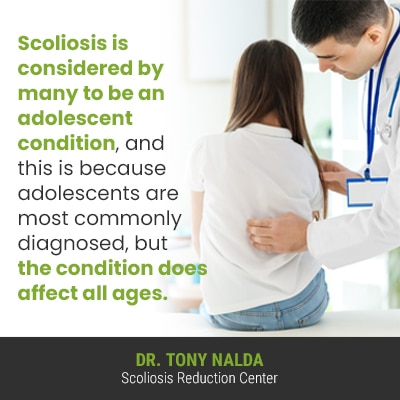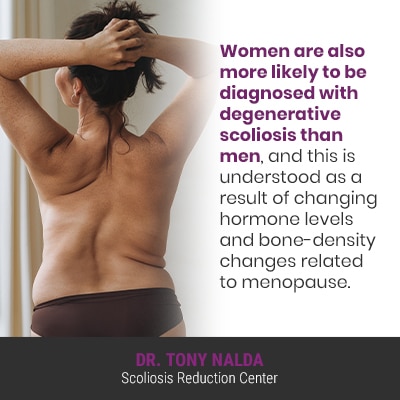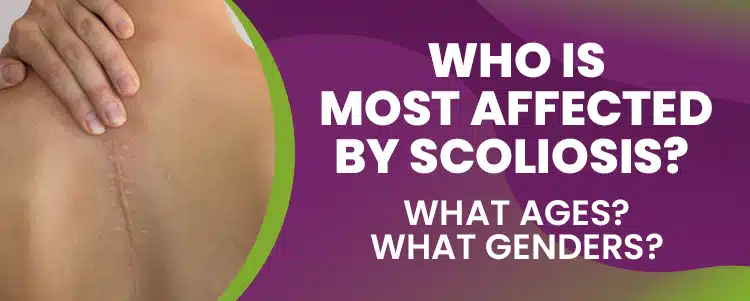Scoliosis can affect any age, but is mainly considered a child and adolescent condition because children and adolescents are most commonly diagnosed. Females are also more likely to be diagnosed and experience significant progression, particularly if left untreated, or not treated proactively; continue reading to find out why.
Scoliosis is a highly-variable spinal condition, not only because it ranges widely in severity and has multiple condition types, but also because it affects all ages; however, scoliosis is most commonly diagnosed in adolescents between the ages of 10 and 18, and is more prevalent in females.
In order to address who is most affected by scoliosis, let’s start by talking about some different condition types.
Different Types of Scoliosis
There is rarely a clear-cut answer when it comes to questions regarding scoliosis, including who is most affected because different types affect different ages.
The most common type of scoliosis to affect both children and adults is idiopathic scoliosis, and the idiopathic classification means not clearly associated with a single-known cause.
In fact, idiopathic scoliosis accounts for approximately 80 percent of known diagnosed cases, and the remaining 20 percent are types associated with known causes: neuromuscular scoliosis, degenerative scoliosis, and congenital scoliosis.
While we don’t fully understand what causes the initial onset of idiopathic scoliosis, we do know what triggers its progression: growth and development.
As a progressive condition, scoliosis has it in its nature to worsen over time, especially if it’s left untreated, and this is true of all condition types in all ages.
Now, the most common type of idiopathic scoliosis is the condition’s most-prevalent type overall: adolescent idiopathic scoliosis, diagnosed between the ages of 10 and 18, so let’s take a minute to explore this age group and how gender factors into condition prevalence.
Who Does Scoliosis Affect Most: Adolescent Idiopathic Scoliosis

Scoliosis is considered by many to be an adolescent condition, and this is because adolescents are most commonly diagnosed, but the condition does affect all ages.
As adolescents are in, or are entering into, the stage of puberty, this age group is most at risk for rapid-phase progression because growth and development is the condition’s main progressive trigger.
In addition, adolescent idiopathic scoliosis is not only more frequently diagnosed in females, females are also more likely to experience significant progression than males.
Who is Scoliosis Most Common in?
So scoliosis is the most common in adolescents between the ages of 10 and 18, and as it’s more prevalent in females, female adolescents are most commonly affected by scoliosis.
According to the American Academy of Orthopaedic Surgeons, females are 10 times more likely to develop adolescent idiopathic scoliosis, before the age of 10, than males of the same age.
In addition, females are also approximately 10 times more likely to experience progression than boys of the same age.
Scoliosis progressing means the size of the unnatural spinal curve is increasing, as are the uneven forces the condition is introducing to the body, and their effects.
As the onset of adolescent idiopathic scoliosis is unclear, there are a number of theories regarding why idiopathic scoliosis is more prevalent in female adolescents and why progression is also more likely in females than males.
The most common theory involves hormones. As we know that puberty is hormone-driven, and females tend to start puberty earlier than males, this early initiation into puberty could account for the higher prevalence in female adolescents.
Leptin is an important hormone for regulating hunger, but it is also closely tied to growth and reproduction.
It’s also thought that leptin plays a large role in body weight, bone growth, initiating puberty, and dysfunction of the sympathetic nervous system.
Leptin helps manage weight, and lower levels of circulating leptin in adolescent girls is further connected to low body-mass index (BMI), and there are a number of theories regarding the connection between low BMI, the development of idiopathic scoliosis in females, and the higher prevalence in females than males, who tend to not have as low BMI levels as females of the same age.
The low-BMI theory claims that scoliosis is more common in females because there is an altered sensitivity to leptin in females, which elevates the activity of the sympathetic nervous system (SNS), making them more susceptible to AIS development.
This theory asserts that increased activity of the sympathetic nervous system contributes to the development of AIS by encouraging early puberty, increased height, lower BMI, higher growth velocity, and reaching skeletal maturity faster.
There are also other hormone theories, such as melatonin and Vitamin D deficiencies, but there isn’t a large amount of research to support a melatonin and/or Vitamin D-related causation.
So now that we know scoliosis is most prevalent in adolescents, and more common in females than males, what about adults?
Scoliosis in the Aging Population
While scoliosis is most prevalent in adolescents, it can affect all ages from infants to the elderly and every age in between, and when it comes to the topic of scoliosis in adults, an interesting thing happens: the actual rate of scoliosis increases with age.
The two most common types of scoliosis to affect adults are idiopathic and degenerative.
When it comes to idiopathic scoliosis in adults, these are cases of adolescent idiopathic scoliosis that went undiagnosed and untreated during adolescence; commonly, the condition doesn’t start producing overt symptoms until significant progression has occurred and/or until skeletal maturity has been reached, as this is when the condition becomes compressive and painful.
Pain is what brings most adults in to see me for a diagnosis and treatment, while postural deviation is the most common sign symptom in children and adolescents.
The second most-prevalent type to affect adults is degenerative, and this is most common in adults over the age of 40, and is caused by natural age-related spinal degeneration.

Women are also more likely to be diagnosed with degenerative scoliosis than men, and this is understood as a result of changing hormone levels and bone-density changes related to menopause.
The interesting thing is that while scoliosis is most-commonly diagnosed in children and adolescents, when paired with the degenerative effect of aging on the spine, the actual rate of scoliosis increases with age.
Studies that explore the prevalence of scoliosis in adults put rates of scoliosis in adults at between 12 and 20 percent, with one study looking at the prevalence of scoliosis in healthy adults 60+ years of age finding rates as high as 68 percent.
Studies put the rate of scoliosis in adolescents within a range of 0.47 to 5.2 percent, and while rates can fluctuate, it’s clear that the actual rate of scoliosis increases with age.
Scoliosis in Babies
As we’ve taken a look at the prevalence of scoliosis in adolescents and adults, let’s talk about babies.
Congenital scoliosis develops in utero as the spine is forming; this rare form is caused by a malformation within the spine itself that’s present at birth.
Types of spinal malformations can include misshapen vertebrae or vertebral bodies failing to separate, instead becoming fused together into one solid bone and causing the development of a scoliotic curve.
Congenital scoliosis, however, isn’t common and affects approximately 1 in 10,000.
Conclusion
To clearly answer the question, what age is scoliosis commonly found in, the most common age group that scoliosis is diagnosed within is adolescents between the ages of 10 and 18.
Adolescent idiopathic scoliosis is the condition’s most prevalent type, but scoliosis can also affect babies, infants, juveniles, adults, and the elderly.
Although scoliosis is diagnosed more often in children and adolescents, the actual rate of scoliosis does increase with age, and this is understood as a result of growth triggering onset and progression, and age-related spinal degeneration increasing the incidence of scoliosis in the aging population.
When a baby is born with scoliosis, this is classified as congenital scoliosis, and when scoliosis develops between the ages of 6 months and 3 years old, this is considered infantile scoliosis.
Scoliosis that develops between the ages of 3 and 10 is classified as juvenile early-onset scoliosis.
Adult scoliosis is diagnosed in those who have reached skeletal maturity, and as scoliosis doesn’t become a compressive condition until skeletal maturity has been reached, this is when scoliosis tends to become painful.
Here at the Scoliosis Reduction Center®, I’ve treated all types of scoliosis and patients of all ages, and the most important thing to remember is that regardless of age and gender, the best time to start scoliosis treatment is always now.
While there are no treatment guarantees, treatment started early in a condition’s progressive line is more likely to be successful; the only way to work towards counteracting the condition’s progressive nature is through proactive treatment.
So remember, although adolescent females are the most affected by scoliosis, the condition can affect people of all ages and genders.




